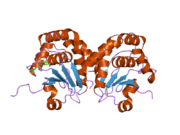| DUSP15 |
|---|
 |
| Available structures |
|---|
| PDB | Ortholog search: PDBe RCSB |
|---|
|
|
| Identifiers |
|---|
| Aliases | DUSP15, VHY, C20orf57, dual specificity phosphatase 15 |
|---|
| External IDs | OMIM: 616776; MGI: 1934928; HomoloGene: 33586; GeneCards: DUSP15; OMA:DUSP15 - orthologs |
|---|
| Gene location (Human) |
|---|
 | | Chr. | Chromosome 20 (human)[1] |
|---|
| | Band | 20q11.21 | Start | 31,847,637 bp[1] |
|---|
| End | 31,870,664 bp[1] |
|---|
|
| Gene location (Mouse) |
|---|
 | | Chr. | Chromosome 2 (mouse)[2] |
|---|
| | Band | 2|2 H1 | Start | 152,782,917 bp[2] |
|---|
| End | 152,793,618 bp[2] |
|---|
|
| RNA expression pattern |
|---|
| Bgee | | Human | Mouse (ortholog) |
|---|
| Top expressed in | - left testis
- right testis
- tibial nerve
- human kidney
- sperm
- testicle
- C1 segment
- Descending thoracic aorta
- right coronary artery
- vena cava
|
| | Top expressed in | - sciatic nerve
- spermatocyte
- spermatid
- seminiferous tubule
- deep cerebellar nuclei
- pontine nuclei
- epithelium of lens
- cerebellar cortex
- anterior horn of spinal cord
- medial vestibular nucleus
|
| | More reference expression data |
|
|---|
| BioGPS | |
|---|
|
| Gene ontology |
|---|
| Molecular function | - phosphoprotein phosphatase activity
- hydrolase activity
- protein binding
- phosphatase activity
- protein tyrosine phosphatase activity
- protein tyrosine/serine/threonine phosphatase activity
| | Cellular component | - membrane
- cytoplasm
- cytosol
- plasma membrane
| | Biological process | - positive regulation of JNK cascade
- transforming growth factor beta receptor signaling pathway
- protein dephosphorylation
- regulation of cell population proliferation
- peptidyl-tyrosine dephosphorylation
- dephosphorylation
- regulation of oligodendrocyte differentiation
| | Sources:Amigo / QuickGO |
|
| Orthologs |
|---|
| Species | Human | Mouse |
|---|
| Entrez | | |
|---|
| Ensembl | | |
|---|
| UniProt | | |
|---|
| RefSeq (mRNA) | |
|---|
NM_177991
NM_001012644
NM_080611
NM_001320478
NM_001320479 |
| |
|---|
| RefSeq (protein) | |
|---|
NP_001012662
NP_001307407
NP_001307408
NP_542178
NP_817130 |
| |
|---|
| Location (UCSC) | Chr 20: 31.85 – 31.87 Mb | Chr 2: 152.78 – 152.79 Mb |
|---|
| PubMed search | [3] | [4] |
|---|
|
| Wikidata |
| View/Edit Human | View/Edit Mouse |
|

 1yz4: Crystal structure of DUSP15
1yz4: Crystal structure of DUSP15


















